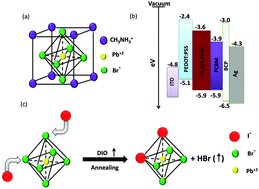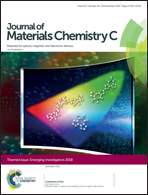Influence of solvent additive on the chemical and electronic environment of wide bandgap perovskite thin films†
Abstract
We provide in-depth insight into the role of 1,8-diiodooctane (DIO) as a solvent additive in wide bandgap CH3NH3PbBr3 (MAPbBr3) films which results in altering the kinetics of crystal growth. A detailed experimental investigation based on structural change, electronic states and chemical analysis is carried out to determine the possible mechanism which provides the control to tune the chemical environment of the perovskite film. We experimentally verify the proposed model where iodine being a soft Lewis base has a tendency to chelate with a soft Lewis acid (lead, Pb). I–Pb chelation is evident in optical and structural studies of MAPbBr3 thin films. Ultraviolet photoelectron spectroscopy (UPS) studies demonstrate that the electronic states of perovskite thin films can be modulated with a fractional concentration of DIO in the perovskite precursor solution. Chemical analysis using high resolution XPS of perovskite films shows the lower binding energies of bromine (Br 3d) and lead (Pb 4f) with DIO additive films, and confirmed the replacement of Br− with I− in agreement with UPS, optical and structural studies. A prominent appearance of an additional hump next to the Pb 4f peak in the film without the DIO additive is due to metallic lead's presence in the film, which acts as a bulk trap in the perovskite film. Hence, incorporation of DIO into the perovskite precursor solution reduces the recombination centers, which enhances the performance of perovskite solar cells and light emitting diodes.

- This article is part of the themed collection: Journal of Materials Chemistry C Emerging Investigators


 Please wait while we load your content...
Please wait while we load your content...